Mutually Complementary Measure-Correlate-Predict Method for Enhanced Long-Term Wind-Resource Assessment
Abstract
1. Introduction
2. Theories
2.1. Wind Characteristics
2.2. Extreme Wind Speed
2.3. Mutually Complementary Measure-Correlate-Predict Method
- In step, categorize all the datasets collected at a wind farm and near a site with regards to each wind direction. The number of direction sectors depends on the site characteristics. Optimum numbers can be decided by observing the wind rose of a site. In general, 12 sectors are used.
- In step ②, use the categorized data to calculate the coefficient of determination between datasets using Equation (13). Note that using many measured sample datasets enhances the accuracy and reliability of the mutually complementary MCP method in analyzing wind resources, similar to any other MCP method.where and denote the measured data from each met-mast.
- Once correlations among all the datasets are calculated, the sections with very poor correlations between datasets are selected and removed in step ③, because data that are poorly correlated have lower reliability for the prediction of long-term wind potentials. Generally, datasets showing R2 > 0.8 are recommended to ensure accuracy and reliability in an MCP process [46].
- In step ④, sort sections in descending order of correlations and count the number of datasets.
- Use the dataset with the highest correlation to recreate the data of a recoverable period by primarily using a regression analysis in step ⑤. Then, use the datasets with the highest correlations to recreate the data of the recoverable periods. Note that the data obtained at each met-mast become a reference for those obtained at other met-masts.
- Finally, the long-term wind data from all met-masts are serially ordered and recreated in a mutually complementary manner.
3. Evaluation and Characterization of Wind Resources
3.1. Site and Data Description
3.2. Long-Term Wind Characteristics
4. Assessment of Site Compliances and Energy Production
4.1. Site Compliances
4.2. Assessment of Energy Production
5. Conclusions
- The mutually complementary MCP method is simple yet effective for sites characterized by seasonal and year-on-year variations, where long-term reference data for estimating wind potentials and EWS are unavailable. The various periods of missing data corresponding to different masts result in the inconsistent determination of turbine classes based on the EWS, thereby confounding the estimation of site compliance.
- Because of extensively variable wind distributions, the energy density is a more sensitive metric than the mean wind speed for sites characterized by seasonal and year-on-year variations. Specifically, a difference of up to 4% in the shape factor results in a change of over 20% in the mean energy density .
- Similarly, the scale factor and the shape factor , which govern the energy density of the site, are more important than the mean wind speed .
- The seasonal variation in the air density should be considered when calculating , as the variations in cause an error in the prediction of long-term wind potential.
Author Contributions
Funding
Conflicts of Interest
Nomenclature
| Abbreviations | |
| AEP | Annual energy production |
| CF | Capacity factor |
| CV | Coefficient of variance |
| EWS | Extreme wind speed |
| IEC | International Electrotechnical Commission |
| 10-min mean turbulence intensity | |
| MERRA | Modern-Era Retrospective Analysis for Research and Application |
| MCP | Measure-correlate-predict |
| NCAR | National Center for Atmospheric Research |
| NCEP | National Centers for Environmental Prediction |
| Variables or parameters | |
| Air pressure | |
| Total number of samples | |
| Gumbel distribution graph | |
| Energy density | |
| Power curve | |
| Coefficient of determination | |
| Gas constant of dry air, 287.05 J/(kg K) | |
| Weibull plotting position | |
| Absolute air temperature | |
| Extreme wind speed | |
| Extreme 10-min mean wind speed with a recurrence period of 50 years at the height of a turbine hub | |
| Scale factor | |
| Ascending sort order of samples | |
| Shape factor | |
| Number of non-zero wind speed data points | |
| Return period | |
| Number of hours per year | |
| Wind speed | |
| Greek letters | |
| Measure of dispersion | |
| Mode of extreme value distribution | |
| Extracted extreme events per year | |
| Density | |
| Subscripts | |
| Ten-minute averaged values | |
| Wind | |
| Air | |
| Cut-in | |
| Cut-out | |
| Sample of the maximum value | |
| Time stage | |
| Mean | |
References
- Twidell, J.; Weir, T. Renewable Energy Resources, 2nd ed.; Taylor Francis E-Library: Oxfordshire, UK, 2006. [Google Scholar]
- Oh, K.-Y.; Nam, W.; Ryu, M.S.; Kim, J.-Y.; Epureanu, B.I. A review on the foundations of offshore wind energy convertors: Current Status and future perspectives. Renew. Sustain. Energy Rev. 2018, 88, 16–36. [Google Scholar] [CrossRef]
- Dong, L. Wind resource assessment in the southern plains of the US: Characterizing large-scale atmospheric circulation with cluster analysis. Atmosphere 2018, 9, 110. [Google Scholar] [CrossRef]
- Ruiz, A.; Onea, F.; Rusu, E. Study concerning the expected dynamics of the wind energy resources in the Iberian nearshore. Energies 2020, 13, 4832. [Google Scholar] [CrossRef]
- Menezes, D.; Mendes, M.; Almeida, J.A.; Farinha, T. Wind farm and resource datasets: A comprehensive survey and overview. Energies 2020, 13, 4702. [Google Scholar] [CrossRef]
- Barthelmie, R.J.; Shepherd, T.J.; Aird, J.A.; Pryor, S.C. Power and wind shear implications of large wind turbine scenarios in the US central plains. Energies 2020, 13, 4269. [Google Scholar] [CrossRef]
- Young, I.R.; Kirezci, E.; Ribal, A. The global wind resource observed by scatterometer. Remote Sens. 2020, 12, 2920. [Google Scholar] [CrossRef]
- Global Wind Statistics 2017; Global Wind Energy Council: Brussel, Belgium, 2018.
- Hales, D. Renewables 2018 Global Status Report; IEA: Paris, France, 2018. [Google Scholar]
- IEC 61400 Wind Turbines—Part 1: Design Requirements; IEC: Geneva, Switzerland, 2005.
- IEC 61400 Wind Turbines—Part 3: Design Requirements for Offshore Wind Turbines; IEC: Geneva, Switzerland, 2009.
- Thøgersen, M.L.; Sørensen, T. Measure-Correlate-Predict methods: Case studies and software implementation. In Proceedings of the EWEC-2007, Milan, Italy, 7–10 May 2007. [Google Scholar]
- Kaldellis, J.K.; Kavadias, K.A.; Filios, A.E. A new computational algorithm for the calculation of maximum wind energy penetration in autonomous electrical generation systems. Appl. Energy 2009, 86, 1011–1023. [Google Scholar] [CrossRef]
- Erdem, E.; Shi, J. ARMA based approaches for forecasting the tuple of wind speed and direction. Appl. Energy 2011, 88, 1405–1414. [Google Scholar] [CrossRef]
- Velázquez, S.; Carta, J.A.; Matías, J.M. Comparison between ANNs and linear MCP algorithms in the long-term estimation of the cost per kW h produced by a wind turbine at a candidate site: A case study in the Canary Islands. Appl. Energy 2011, 88, 3869–3881. [Google Scholar] [CrossRef]
- Liu, H.; Erdem, E.; Shi, J. Comprehensive evaluation of ARMA–GARCH(-M) approaches for modeling the mean and volatility of wind speed. Appl. Energy 2011, 88, 724–732. [Google Scholar] [CrossRef]
- Dong, Y.; Wanga, J.; Jiang, H.; Shi, X. Intelligent optimized wind-resource assessment and wind turbines selection in Huitengxile of Inner Mongolia, China. Appl. Energy 2013, 109, 239–253. [Google Scholar] [CrossRef]
- Carvalho, D.; Rocha, A.; Santos, C.S.; Pereira, R. Wind resource modelling in complex terrain using different mesoscale–microscale coupling techniques. Appl. Energy 2013, 108, 493–504. [Google Scholar] [CrossRef]
- Rogers, A.L.; Rogers, J.W.; Manwell, J.F. Comparison of the performance of four measure-correlate-predict algorithms. J. Wind Eng. Ind. Aerodyn. 2005, 93, 243–264. [Google Scholar] [CrossRef]
- Carta, J.A.; Velázquez, S. A new probabilistic method to estimate the long-term wind speed characteristics at a potential wind energy conversion site. Energy 2011, 36, 2674–2685. [Google Scholar] [CrossRef]
- Guo, Z.; Zhao, J.; Zhang, W.; Wang, J. A corrected hybrid approach for wind speed prediction in Hexi Corridor of China. Energy 2011, 36, 1668–1679. [Google Scholar] [CrossRef]
- Ali, S.; Lee, S.-M.; Jang, C.-M. Forecasting the long-term wind data via measure-correlated-predict (MCP) methods. Energies 2018, 11, 1541. [Google Scholar] [CrossRef]
- Xu, C.; Hao, C.; Li, L.; Han, X.; Xue, F.; Sun, M.; Shen, W. Evaluation of the power-law wind-speed extrapolation method with atmospheric stability classification methods for flows over different terrain types. Appl. Sci. 2018, 8, 1429. [Google Scholar] [CrossRef]
- Woods, J.C.; Watson, S.J. A new matrix method of predicting long-term wind roses with MCP. J. Wind Eng. Ind. Aerodyn. 1997, 66, 85–94. [Google Scholar] [CrossRef]
- Lackner, M.A.; Rogers, A.L.; Manwell, J.F. The round robin site assessment method: A new approach to wind energy site assessment. Renew. Energy 2008, 33, 2019–2026. [Google Scholar] [CrossRef]
- Lackner, M.A.; Rogers, A.L.; Manwell, J.F. Uncertainty analysis in mcp-based wind-resource assessment and energy production estimation. J. Sol. Energy Eng. 2008, 130, 031006-1–031006-10. [Google Scholar] [CrossRef]
- Kim, H.-G.; Kim, K.-Y.; Kang, Y.-H. Comparative evaluation of the third-generation reanalysis data for wind resource assessment of the southwestern offshore in South Korea. Atmosphere 2018, 9, 73. [Google Scholar]
- Shi, X.; Lei, X.; Huang, Q.; Huang, S.; Ren, K.; Hu, Y. Hourly day-ahead wind power prediction using the hybrid model of variational model decomposition and long short-term memory. Energies 2018, 11, 3227. [Google Scholar] [CrossRef]
- Liu, H.; Duan, Z.; Chen, C.; Wu, H. A novel two-stage deep learning wind speed forecasting method with adaptive multiple error corrections and bivariate Dirichlet process mixture model. Energy Convers. Manag. 2019, 199, 111975. [Google Scholar] [CrossRef]
- Jang, J.-K.; Yu, B.-M.; Ryu, K.-W.; Lee, J.-S. Offshore wind-resource assessment around Korean Peninsula by using QuikSCAT satellite data. J. Korean Soc. Aeronaut. Space Sci. 2009, 37, 1121–1130. [Google Scholar]
- Chelton, D.B.; Freilich, M.H.; Sienkiewicz, J.M.; Ahn, J.M.V. On the use of QuikSCAT scatterometer measurements of surface winds for marine weather prediction. Mon. Weather Rev. 2006, 134, 2055–2071. [Google Scholar] [CrossRef]
- GMAO. Global Modeling and Assimilation Office. 2014. Available online: http://gmao.gsfc.nasa.gov/merra/ (accessed on 14 August 2019).
- Rhee, J.; Im, J. Estimating high spatial resolution air temperature for regions with limited in situ data using MODIS products. Remote Sens. 2014, 6, 7360–7378. [Google Scholar] [CrossRef]
- Burton, T.; Sharpe, D.; Jenkins, N.; Bossanyi, E. Wind Energy Handbook; Wiley: Hoboken, NJ, USA, 2001. [Google Scholar]
- Chang, T.J.; Wu, Y.-T.; Hsu, H.-Y.; Chu, C.-R.; Liao, C.-M. Assessment of wind characteristics and wind turbine characteristics in Taiwan. Renew. Energy 2003, 28, 851–871. [Google Scholar] [CrossRef]
- Shoaib, M.; Siddiqui, I.; Amir, Y.M.; Rehman, S.U. Evaluation of wind power potential in Baburband (Pakistan) using Weibull distribution function. Renew. Sustain. Energy Rev. 2017, 70, 1343–1351. [Google Scholar] [CrossRef]
- Seguro, J.V.; Lambert, T.W. Modern estimation of the parameters of the Weibull wind speed distribution for wind energy analysis. J. Wind Eng. Ind. Aerodyn. 2000, 85, 75–84. [Google Scholar] [CrossRef]
- Justus, C.G.; Hargraves, W.R.; Mikhail, A.; Graber, D. Methods for estimating wind speed frequency distributions. J. Appl. Meteorol. 1978, 17, 350–353. [Google Scholar] [CrossRef]
- Gipe, P. Wind Power: Renewable Energy for Home, Farm, and Business, 2nd ed.; Chelsea Green Publishing: Chelsea, VT, USA, 2004. [Google Scholar]
- Dicorato, M.; Forte, G.; Pisani, M.; Trovato, M. Guidelines for assessment of investment cost for offshore wind generation. Renew. Energy 2011, 36, 2043–2051. [Google Scholar] [CrossRef]
- Kim, J.-Y.; Oh, K.-Y.; Kang, K.-S.; Lee, J.-S. Site selection of offshore wind farms around the Korea Peninsula through economic evaluation. Renew. Energy 2013, 54, 189–195. [Google Scholar] [CrossRef]
- Oh, K.-Y.; Kim, J.-Y.; Lee, J.-S.; Ryu, K.-W. Wind-resource assessment around Korean Peninsula for feasibility study on 100MW class offshore wind farm. Renew. Energy 2012, 42, 217–226. [Google Scholar] [CrossRef]
- Kotz, S.; Nadarajah, S. Extreme Value Distributions: Theory and Applications; Imperial College Press: London, UK, 2000. [Google Scholar]
- Palutikof, J.P.; Brabson, B.B.; Lister, D.H.; Adcock, S.T. A review of methods to calculate extreme wind speeds. Meteorol. Appl. 1999, 6, 119–132. [Google Scholar] [CrossRef]
- An, Y.; Pandey, M.D. A comparison of methods of extreme wind speed estimation. J. Wind Eng. Ind. Aerodyn. 2005, 93, 535–545. [Google Scholar] [CrossRef]
- EMD. Course Book for WindPRO Training—Basic; EMD: Darmstadt, Germany, 2010. [Google Scholar]
- Annex, G. (Ed.) IEC 61400 Wind Turbines—Part 12-1: Power Performance Measurements of Electricity Producing Wind Turbines; IEC: Geneva, Switzerland, 2005. [Google Scholar]
- Kim, J.-Y.; Oh, K.-Y.; Kim, M.-S.; Kim, K.-Y. Evaluation and characterization of offshore wind resources with long-term met mast data corrected by wind lidar. Renew. Energy 2019, 144, 41–55. [Google Scholar] [CrossRef]
- Oh, K.-Y.; Kim, J.-Y.; Lee, J.-K.; Ryu, M.-S.; Lee, J.-S. An assessment of wind energy potential at the demonstration offshore wind farm in Korea. Energy 2012, 46, 555–563. [Google Scholar] [CrossRef]

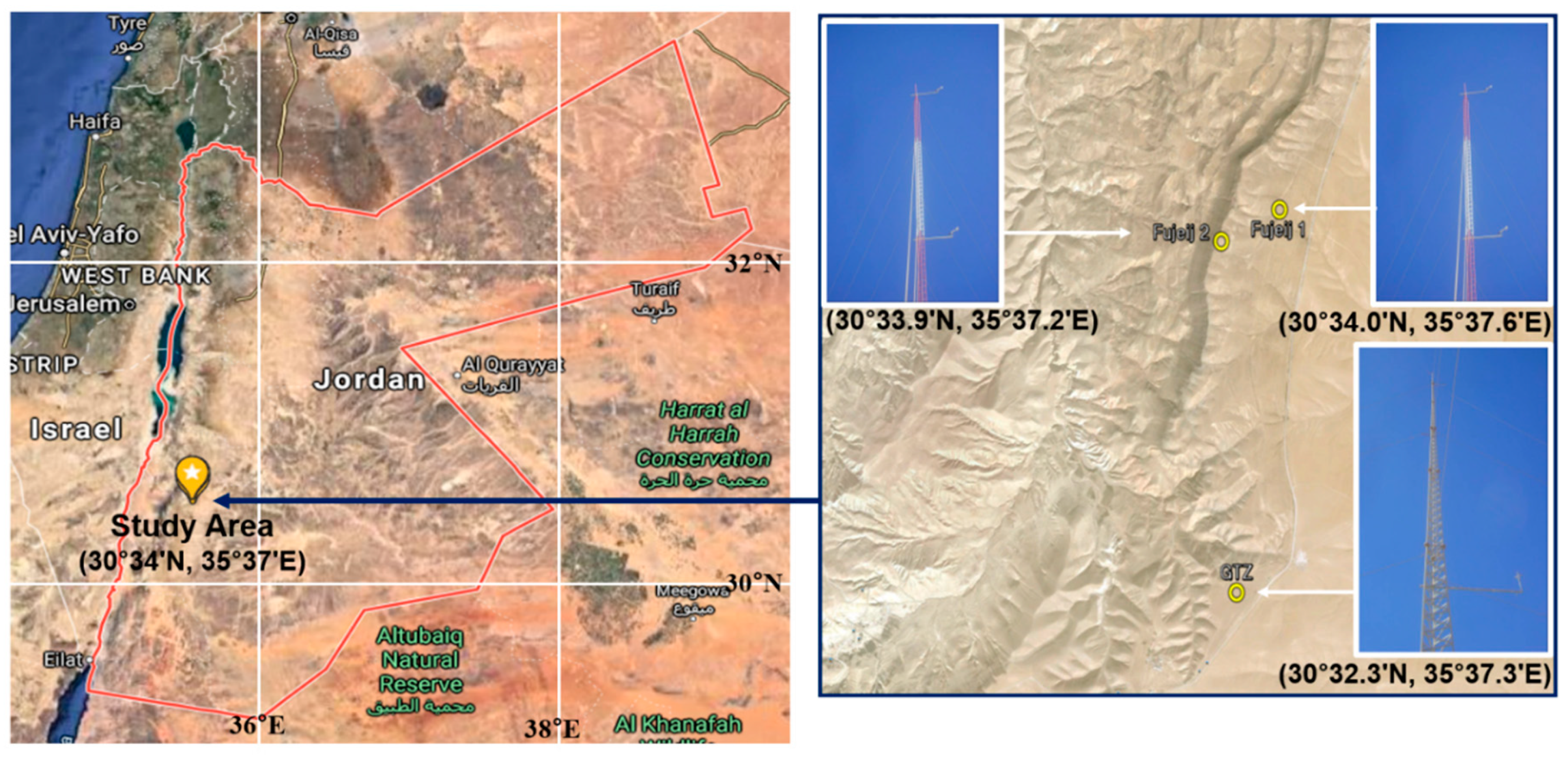


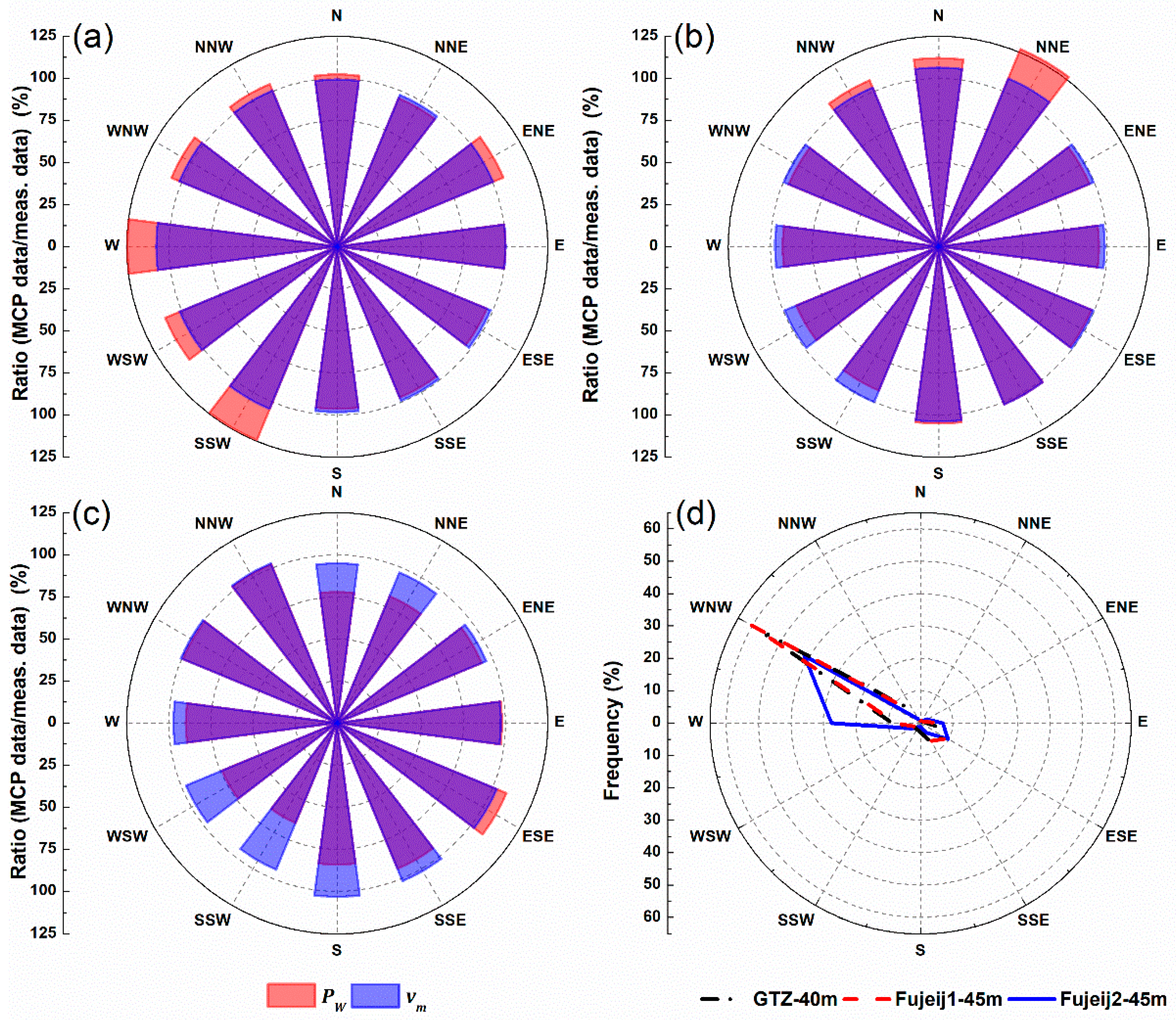
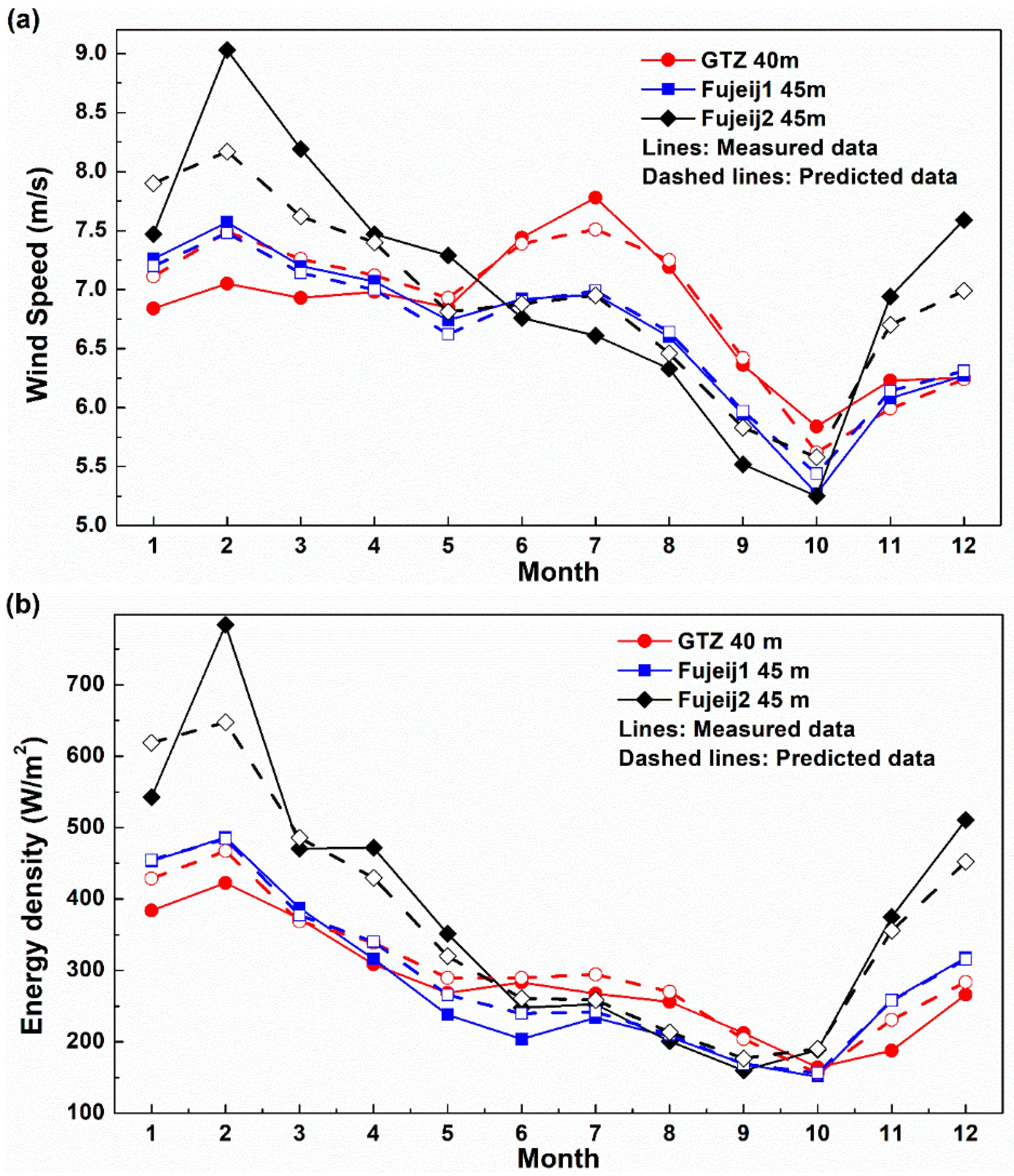
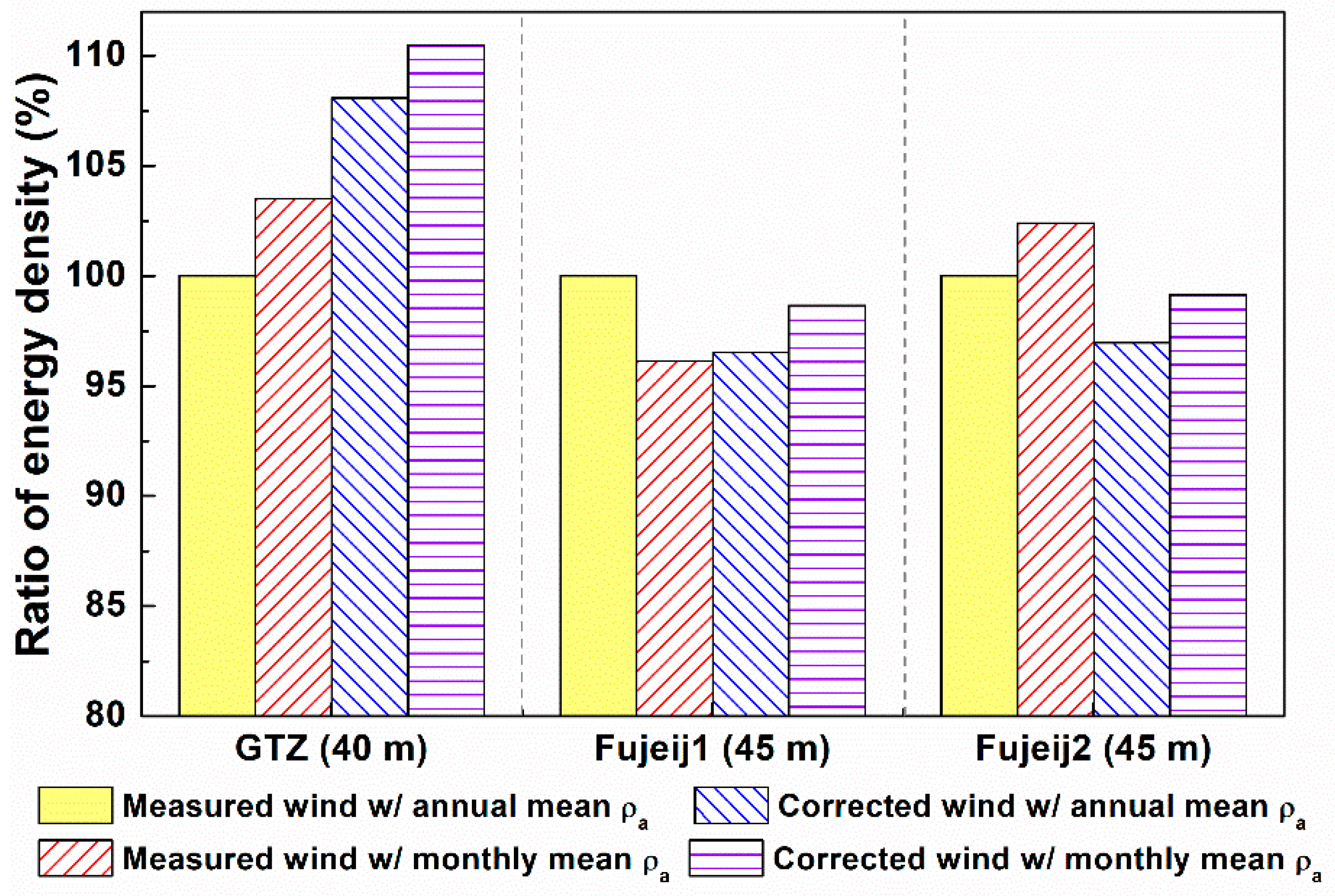
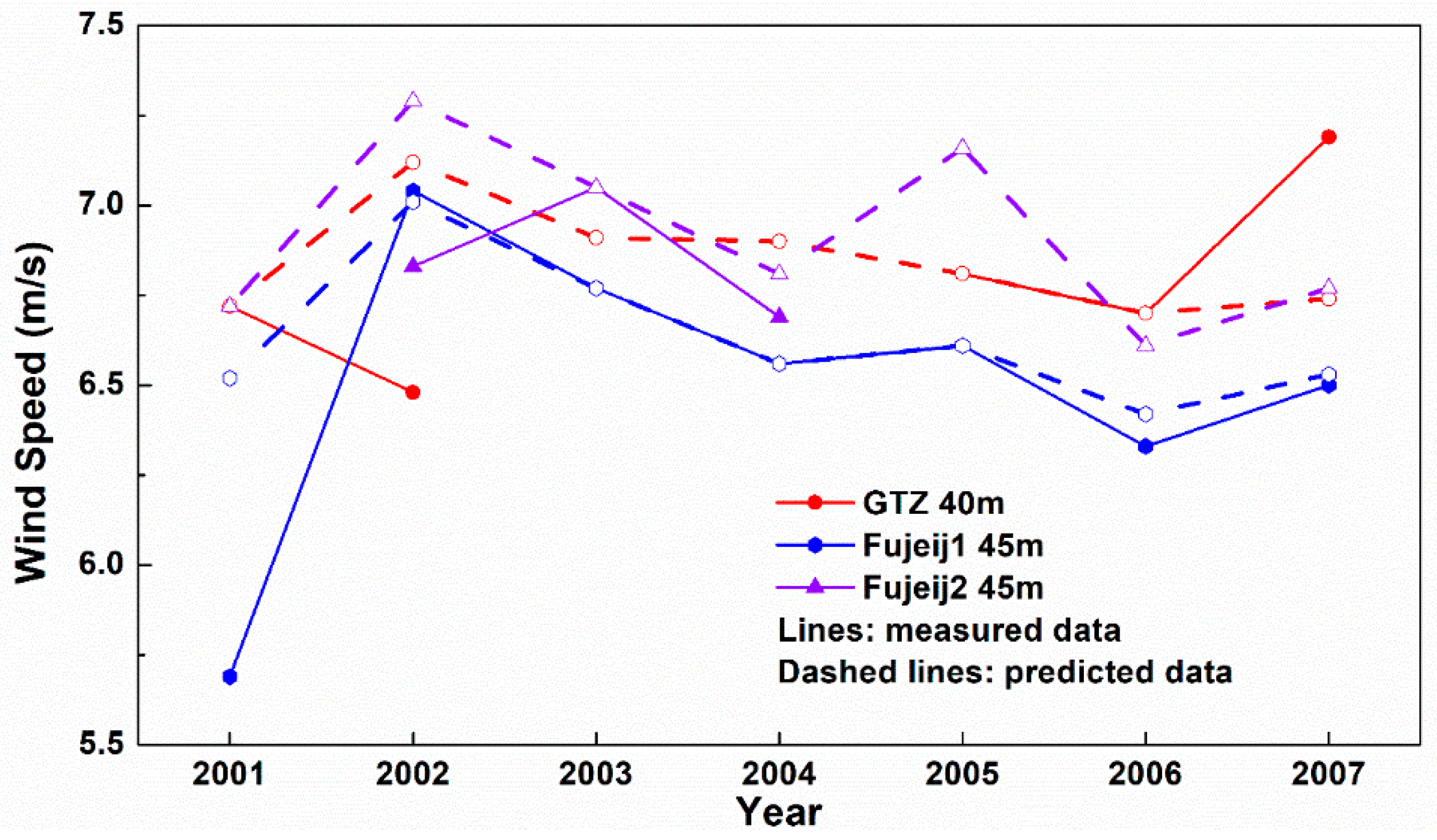
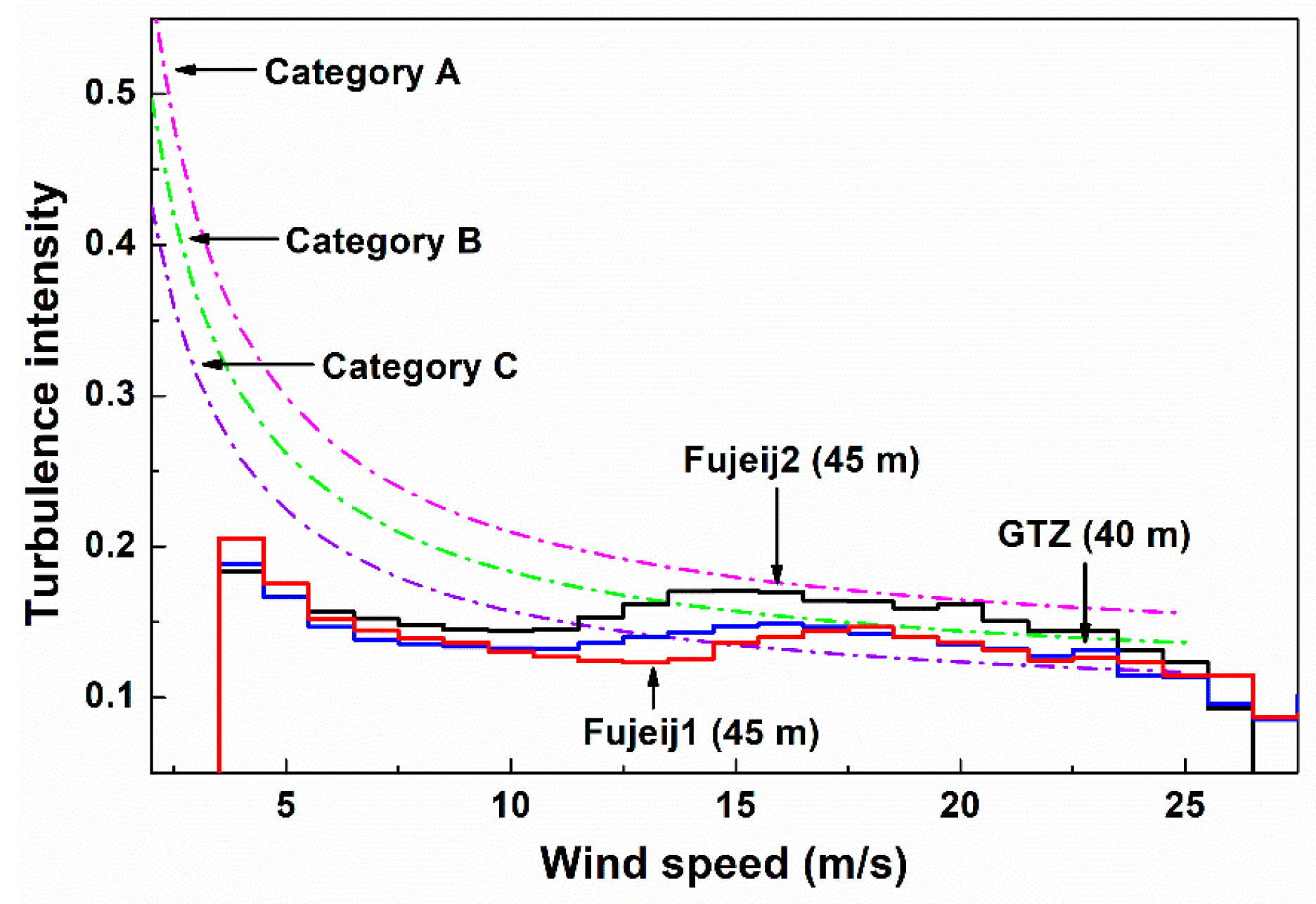
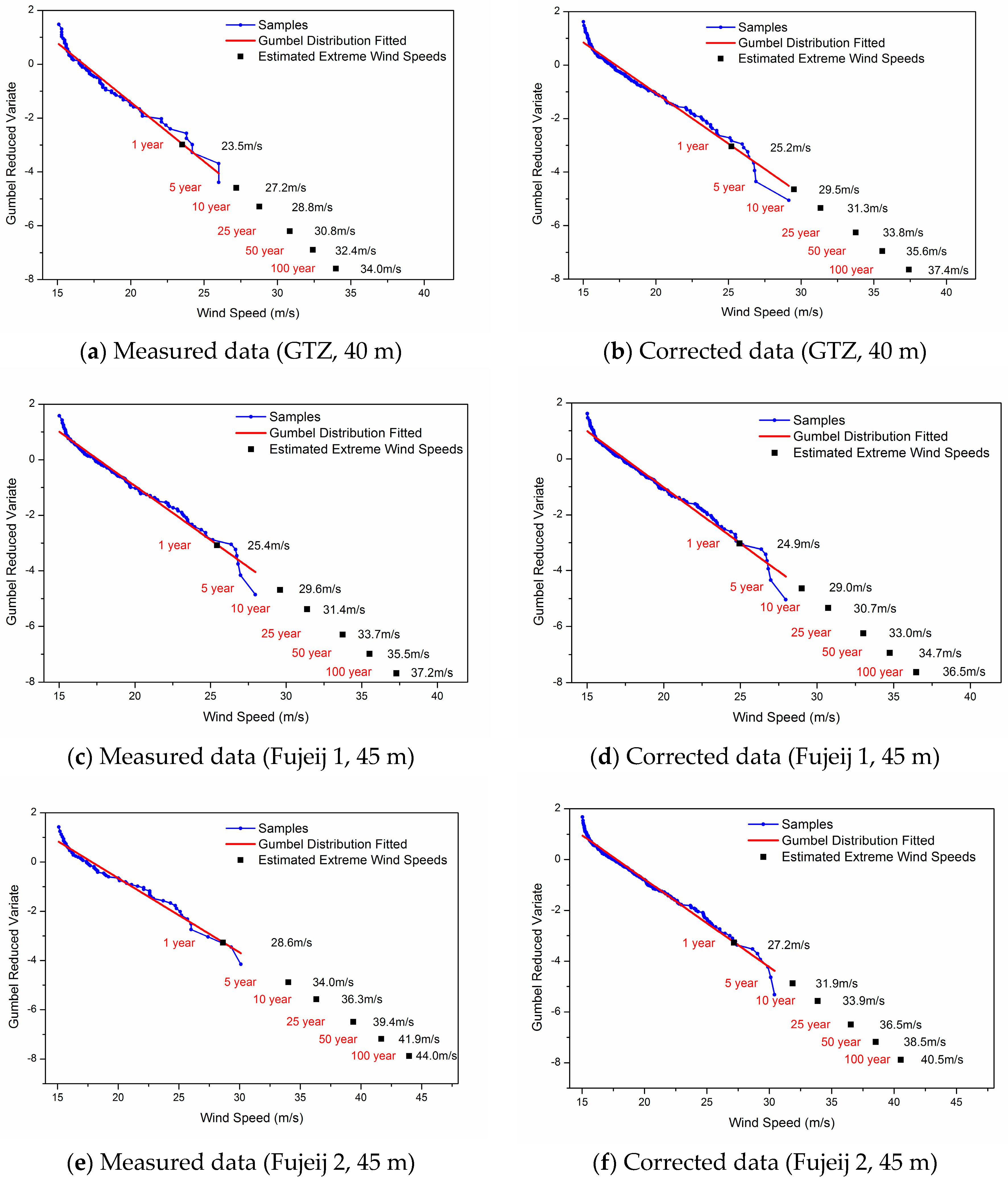
| Name | Latitude | Longitude | Measurement Period | Mean Interval | Measurement Heights |
|---|---|---|---|---|---|
| GTZ | N 30°32.293′ | E 35°37.347′ | August 2000–February 2008 | 10 min | 10 m and 40 m |
| Fujeij 1 | N 30°34.049′ | E 35°’37.615′ | December 2001–February 2008 | 10 min | 30 m and 45 m |
| Fujeij 2 | N 30°33.991′ | E 35°’37.250′ | June 2002–December 2006 | 10 min | 30 m and 45 m |
| GTZ | Fujeij 1 | Fujeij 2 | |||||
|---|---|---|---|---|---|---|---|
| 10 m | 40 m | 30 m | 45 m | 30 m | 45 m | ||
| Scale factor () | Measured data | 6.76 | 7.62 | 7.28 | 7.51 | 7.66 | 7.85 |
| Predicted data | 6.80 | 7.71 | 7.24 | 7.49 | 7.74 | 7.91 | |
| Difference (%) | −0.59 | −1.17 | 0.55 | 0.27 | −1.03 | −0.76 | |
| Shape factor () | Measured data | 2.25 | 2.29 | 1.99 | 2.00 | 1.81 | 1.86 |
| Predicted data | 2.16 | 2.20 | 2.05 | 2.05 | 1.88 | 1.94 | |
| Difference (%) | 4.17 | 4.09 | −2.93 | −2.44 | −3.72 | −4.12 | |
[m/s] | Measured data | 5.99 | 6.75 | 6.40 | 6.60 | 6.70 | 6.90 |
| Predicted data | 6.02 | 6.83 | 6.41 | 6.63 | 6.80 | 6.92 | |
| Difference (%) | −0.58 | −0.02 | −0.16 | −0.45 | −1.47 | −0.29 | |
[W/m2] | Measured data | 194.6 | 273.1 | 269.9 | 296.6 | 352.2 | 370.7 |
| Predicted data | 205.4 | 295.2 | 258.3 | 286.3 | 347.8 | 359.5 | |
| Difference (%) | −5.53 | −8.08 | 5.31 | 4.47 | 1.24 | 3.01 | |
| Wind Turbine Class | I | II | III | S |
|---|---|---|---|---|
| (m/s) | 50 | 42.5 | 37.5 | Values specified by the designer |
| A | 0.16 | |||
| B | 0.14 | |||
| C | 0.12 | |||
| GTZ, 40 m | Fujeij 1, 45 m | Fujeij 2, 45 m | |||||
|---|---|---|---|---|---|---|---|
| 40 m | 80 m | 45 m | 80 m | 45 m | 80 m | ||
[m/s] | Measured data | 32.4 | 34.5 | 35.5 | 36.5 | 41.9 | 42.6 |
| Corrected data | 35.6 | 38.0 | 34.7 | 35.7 | 38.5 | 39.2 | |
| Difference (%) | 8.99 | 9.21 | 2.31 | 2.24 | 8.31 | 8.16 | |
| Wind turbine class | Measured data | I, II, and III | I, II, and III | I | |||
| Corrected data | I and II | I, II, and III | I and II | ||||
| CV * [%] | Measured data | 6.3 | 5.0 | 9.3 | |||
| Corrected data | 4.6 | 4.6 | 4.2 | ||||
| Difference (%) | 36.96 | 8.70 | 121.43 | ||||
| Manufacturer | Turbine Class | Rated Power (kW) | Rotor Diameter (m) | AEP (MWh) | AEP/MW (MWh) | CF (%) |
|---|---|---|---|---|---|---|
| VESTAS | IIA | 3000 | 112 | 9158 | 3053 | 34.8 |
| Alstom | IIA | 3000 | 110 | 8945 | 2982 | 34.0 |
| Gamesa | IIA | 4500 | 128 | 13,312 | 2958 | 33.8 |
| REpower | IIA | 3300 | 104 | 9114 | 2762 | 31.5 |
| Alstom | IA | 3000 | 100 | 8076 | 2692 | 30.7 |
| REpower | IB | 5000 | 126 | 12,519 | 2504 | 28.6 |
| Siemens | IA | 3600 | 107 | 8990 | 2497 | 28.5 |
| VESTAS | IA | 2000 | 80 | 4896 | 2448 | 27.9 |
| GE Wind | IB | 3600 | 104 | 8757 | 2433 | 27.8 |
| VESTAS | IIA | 3000 | 90 | 6656 | 2219 | 25.3 |
| ENERCON | IA | 7500 | 127 | 16,353 | 2180 | 24.9 |
Publisher’s Note: MDPI stays neutral with regard to jurisdictional claims in published maps and institutional affiliations. |
© 2020 by the authors. Licensee MDPI, Basel, Switzerland. This article is an open access article distributed under the terms and conditions of the Creative Commons Attribution (CC BY) license (http://creativecommons.org/licenses/by/4.0/).
Share and Cite
Nam, W.; Oh, K.-Y. Mutually Complementary Measure-Correlate-Predict Method for Enhanced Long-Term Wind-Resource Assessment. Mathematics 2020, 8, 1795. https://doi.org/10.3390/math8101795
Nam W, Oh K-Y. Mutually Complementary Measure-Correlate-Predict Method for Enhanced Long-Term Wind-Resource Assessment. Mathematics. 2020; 8(10):1795. https://doi.org/10.3390/math8101795
Chicago/Turabian StyleNam, Woochul, and Ki-Yong Oh. 2020. "Mutually Complementary Measure-Correlate-Predict Method for Enhanced Long-Term Wind-Resource Assessment" Mathematics 8, no. 10: 1795. https://doi.org/10.3390/math8101795
APA StyleNam, W., & Oh, K.-Y. (2020). Mutually Complementary Measure-Correlate-Predict Method for Enhanced Long-Term Wind-Resource Assessment. Mathematics, 8(10), 1795. https://doi.org/10.3390/math8101795






